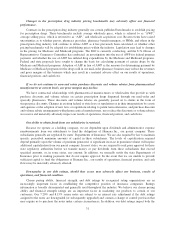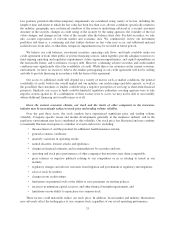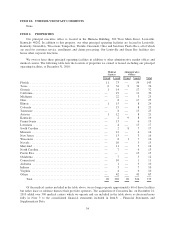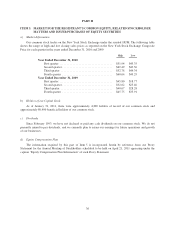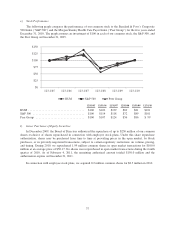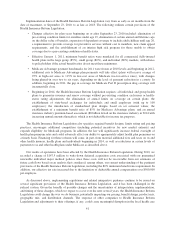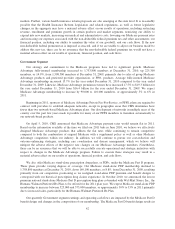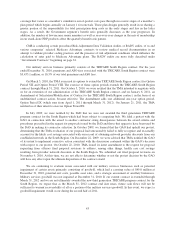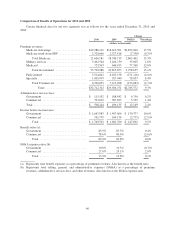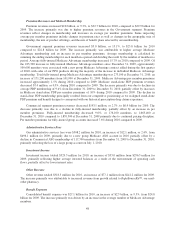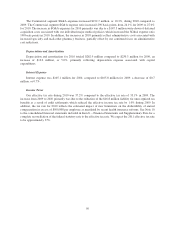Humana 2010 Annual Report Download - page 51
Download and view the complete annual report
Please find page 51 of the 2010 Humana annual report below. You can navigate through the pages in the report by either clicking on the pages listed below, or by using the keyword search tool below to find specific information within the annual report.Implementation dates of the Health Insurance Reform Legislation vary from as early as six months from the
date of enactment, or September 23, 2010, to as late as 2018. The following outlines certain provisions of the
Health Insurance Reform Legislation:
• Changes effective for plan years beginning on or after September 23, 2010 included: elimination of
pre-existing condition limits for enrollees under age 19, elimination of certain annual and lifetime caps
on the dollar value of benefits, expansion of dependent coverage to include adult children until age 26,
a requirement to provide coverage for preventive services without cost to members, new claim appeal
requirements, and the establishment of an interim high risk program for those unable to obtain
coverage due to a pre-existing condition or health status.
• Effective January 1, 2011, minimum benefit ratios were mandated for all commercial fully-insured
health plans in the large group (85%), small group (80%), and individual (80%) markets, with rebates
to policyholders if the actual benefit ratios do not meet these minimums.
• Medicare Advantage payment benchmarks for 2011 were frozen at 2010 levels and beginning in 2012,
additional cuts to Medicare Advantage plan payments will take effect (plans will receive a range of
95% in high-cost areas to 115% in low-cost areas of Medicare fee-for-service rates), with changes
being phased-in over two to six years, depending on the level of payment reduction in a county. In
addition, beginning in 2011, the gap in coverage for Medicare Part D prescription drug coverage will
incrementally close.
• Beginning in 2014, the Health Insurance Reform Legislation requires: all individual and group health
plans to guarantee issuance and renew coverage without pre-existing condition exclusions or health-
status rating adjustments; the elimination of annual limits on coverage on certain plans; the
establishment of state-based exchanges for individuals and small employers (with up to 100
employees); the introduction of standardized plan designs based on set actuarial values; the
establishment of a minimum benefit ratio of 85% for Medicare Advantage plans; and an annual
insurance industry premium-based assessment ($8 billion levied on the insurance industry in 2014 with
increasing annual amounts thereafter), which is not deductible for income tax purposes.
The Health Insurance Reform Legislation also specifies required benefit designs, limits rating and pricing
practices, encourages additional competition (including potential incentives for new market entrants) and
expands eligibility for Medicaid programs. In addition, the law will significantly increase federal oversight of
health plan premium rates and could adversely affect our ability to appropriately adjust health plan premiums on
a timely basis. Financing for these reforms will come, in part, from material additional fees and taxes on us and
other health insurers, health plans and individuals beginning in 2014, as well as reductions in certain levels of
payments to us and other health plans under Medicare as described above.
Our results of operations have been affected by the Health Insurance Reform Legislation. During 2010, we
recorded a charge of $147.5 million to write-down deferred acquisition costs associated with our guaranteed
renewable individual major medical policies since these costs will not be recoverable from our estimates of
future cash flows based on an analysis that considered, among others, our current understanding of the pertinent
provisions of the Health Insurance Reform Legislation, including the 80% minimum benefit ratio requirement. In
addition, our effective tax rate increased due to the limitation of deductible annual compensation over $500,000
per employee.
As discussed above, implementing regulations and related interpretive guidance continue to be issued on
several significant provisions of the Health Insurance Reform Legislation, and it has been challenged in the
judicial system. Given the breadth of possible changes and the uncertainties of interpretation, implementation,
and timing of these changes, which we expect to occur over the next several years, the Health Insurance Reform
Legislation could change the way we do business, potentially impacting our pricing, benefit design, product mix,
geographic mix, and distribution channels. The response of other companies to Health Insurance Reform
Legislation and adjustments to their offerings, if any, could cause meaningful disruption in the local health care
41


